How and how to feed a homemade rose?
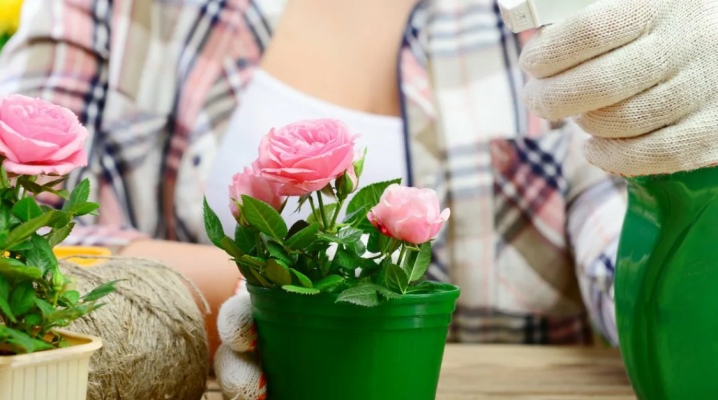
In order for a demanding home rose to always delight its owner, it must be fed regularly. To this end, you can use not only organic preparations and mineral complexes, but also a number of folk remedies.
The need for feeding
You need to feed a home rose in both spring and summer, when young leaves, shoots and flowers begin to appear on the bush. It is better to alternate organics and mineral combinations, maintaining an interval of at least two weeks. In autumn, fertilizers are applied less often and in smaller quantities, and in winter this process stops altogether. In spring, nitrogen and potassium play a key role in the development of culture, and at the end of the season, potassium and phosphorus. Nitrogen mainly contributes to the growth of green mass, potassium prolongs the flowering time, and phosphorus is responsible for the emergence of young root shoots. The home rose accepts both root and foliar feeding well, but it is customary to arrange the latter only during the summer season.
The intake of a number of microelements is, in principle, necessary for a culture for harmonious development. Additional feeding is arranged in cases where the rose shows a deficiency of certain substances. So, the fertilization process will have to be adjusted if the plant grows slower or stops blooming ahead of time. The lack of trace elements is indicated by a change in the color of the leaf blades, the cessation of the formation of buds, or the weakening of the stems.
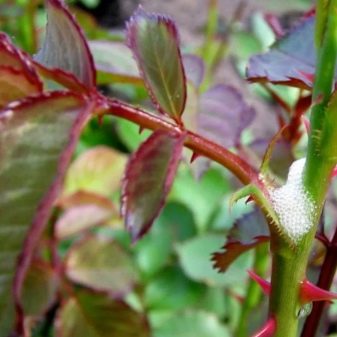

Fertilizer overview
It is possible to feed a homemade rose both with organic matter and with ready-made mineral complexes.
Organic
Natural organic compounds significantly increase the nutritional value of the soil, saturating it with useful elements. So, Chicken droppings are very popular. Absolutely non-toxic product, which has a shelf life of up to 3 years, significantly improves the characteristics of the soil. Moreover, it normalizes its acid balance and does not do any harm to the roots of the culture.
If freshly harvested chicken manure is used, then it will have to be supplemented with water in the amount of 1:20. A substance that has been previously stored for a long time is diluted with a liquid in a ratio of 1:10. The substance must be infused for 5 days in a darkened space, and then mixed again with a liquid base in a ratio of 1: 3. It is best to use the resulting fertilizer during the flowering period of the culture or already before wintering in the role of humus.
Suitable for potted roses and cow dung. The organic composition improves soil properties such as air permeability and moisture permeability, and also saturates the soil with nitrogen, phosphorus, magnesium, calcium and other required trace elements. The mullein fertilization itself is prepared in the same way as the infusion of chicken manure, but it has been infused for 7 days. The resulting substance is diluted with water in a 1: 2 ratio. Fertilizer is used to irrigate the soil under the flowers, and sometimes to spray the top leaves.
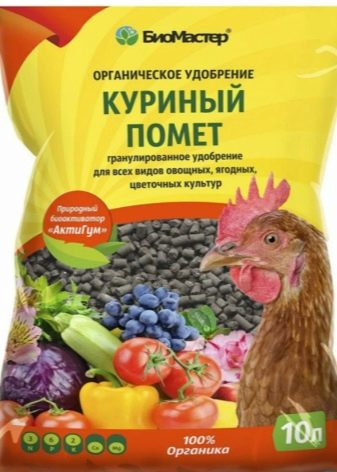
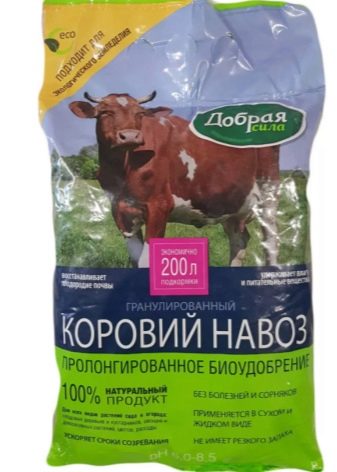
Suitable for crops and a nutritious fertilizer based on weeds, always collected before flowering. The green mass is finely crushed, filled with water and infused for 10 days. When the substance ferments, it will need to be re-diluted with liquid and already used for watering.Fertilizer, which is quickly absorbed into the soil, will be able to normalize its acidity, as well as create a suitable microflora.
Mineral
When choosing mineral dressings, you should focus on their composition, which should contain potassium, phosphorus and nitrogen. For example, potassium sulfate should be used, which accelerates metabolic processes in plant cells, stimulates the growth of seedlings, increases the size of the buds and prolongs the flowering stage. Suitable for home rose and "Agricola", not only nourishes the culture, but also strengthens its immunity. This drug can be purchased in liquid form, as well as in the form of granules or sticks.
Urea, also known as carbamide, helps to build up green mass and better rooting.
All mineral fertilizers must be applied in accordance with the instructions.
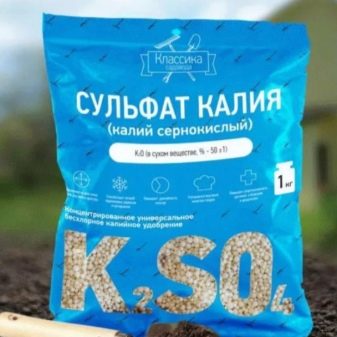

Folk remedies
Most flower growers combine purchased products with homemade recipes. As a rule, they use the usual products found in every kitchen. A rose will react well to sugar, a tablespoon of which is diluted in 0.5 liters of water. Glucose is also suitable, the tablet of which dissolves in a liter of liquid. It is allowed to use such top dressing no more than once a month.
It is very easy to use the coffee grounds - it will be enough to lightly dig it into the ground. Ash is also brought directly into the ground, although some growers prefer to dilute a tablespoon of powder in a liter of liquid base and use the mixture for watering.
Peels of oranges, lemons and other citrus fruits can be filled up to a third of a liter container. Then the contents of the vessel are completely filled with boiling water and infused for 24 hours. Before use, the skins will need to be removed, and a small amount of water, on the contrary, topped up.
Orange peels can be combined with banana peels. Everything is necessarily crushed and, together with a couple of teaspoons of granulated sugar, is placed in a three-liter container. The components are filled with warm water and infused for 21 days with occasional shaking.
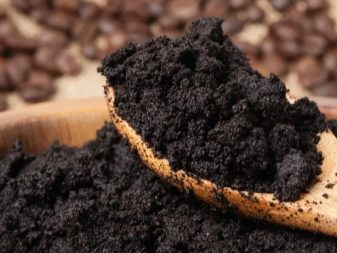
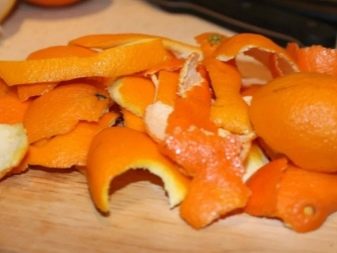
To nourish a homemade rose with yeast, you will need to combine 10 grams of the product, 1 tablespoon of granulated sugar and a liter of liquid base. The mixture is infused for about 2 hours, after which it is diluted in a 1: 1 ratio, used for watering the culture once a month.
Even the husk of onion heads is suitable as a fertilizer. The main component in the amount of 50 grams is combined with 2 liters of water and boiled for 10 minutes. After a 3-hour infusion, the fertilizer will have to be used immediately, spraying the leaf blades from above.
Sometimes tea leaves are used to feed indoor plants, but this should be done with caution so as not to attract pests. In spring and summer, water from under aquarium fish is used as fertilizer, and the liquid remaining after washing the grains of rice or bulgur is also suitable.
Crushed eggshells are buried in the soil right at the roots of the plant. It is also possible to feed a room rose with iodine. The weakened bush is irrigated with a mixture of 7 drops of the drug and properly diluted sodium humate.
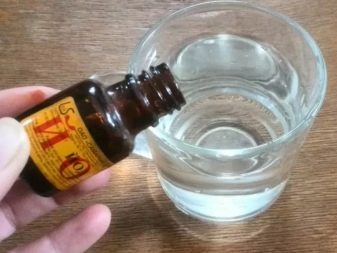
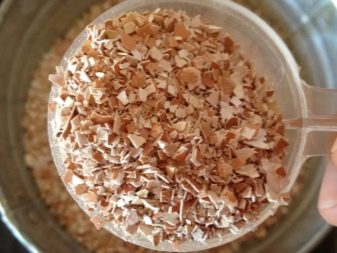
How to fertilize correctly?
It is recommended to feed a room rose growing at home in a pot for the first time in early spring, practically in the first half of March. It is recommended to apply at this stage a complex mineral fertilizer with a high presence of nitrogen - ammophoska, nitrophoska or a ready-made complex for potted roses. Powder or granules are diluted in the base, after which the mixture is used to irrigate the crop. The next feeding is carried out after 2-3 weeks, when leaves already appear on the bush. At this moment, the flower will respond well to organic matter or any folk recipe.
The third feeding, arranged in April, takes place with the use of mineral components, for example, the same fertilizer that was used for the primary feeding. For the flowering of a tea or any other rose, starting in May, potassium and phosphorus are required. The fourth May feeding and the fifth June feeding, organized after 2 weeks, can be carried out using potassium sulfate or superphosphate. In order for roses to bloom in July, potassium, phosphorus and organic matter will have to be used at home this month.
Fertilizer applied at the end of summer should be nitrogen-free. The same applies to the September feeding. In October and November, a home rose is prepared for wintering, and therefore only phosphorus-containing complexes are required for it. In the fall, fertilizing is applied once every two weeks, and then gradually stops.

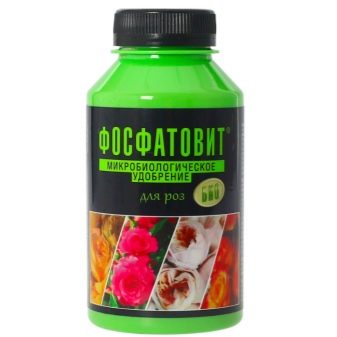
It should also be mentioned that when buying a flower in a store, it is allowed to fertilize it no earlier than a month after planting in a permanent habitat.
Before fertilizing, the roses must be watered with warm water so that the soil warms up and the roots are not burnt. It should also be mentioned that it is better to feed even a houseplant on dry and sunny days, since in cold weather and before precipitation falls, it takes less feeding. If the rose is sick or has just been transplanted, it should not be fertilized.
It should be mentioned that excessive fertilization of a room rose can even harm. The same applies to non-compliance with the timing of the introduction of drugs, as well as to incorrect proportions. As a result, the plant either gets sick, or slows down in development, or dies altogether. Excess nitrogen causes the bush to grow lush and healthy, but will not flower at all or form very few buds. Excessive application of phosphorus results in yellowing and further shedding of leaf blades. In general, excessive concentration of fertilizers in the pot contributes to root burns and further crop death.
An overfed plant requires immediate transport to new soil. If the room is warm, then you can try to wash the excess with water. For this the pot, together with the rose, is immersed in a vessel filled with warm liquid for about 6-8 hours. After the liquid has drained, the rose returns to its place.
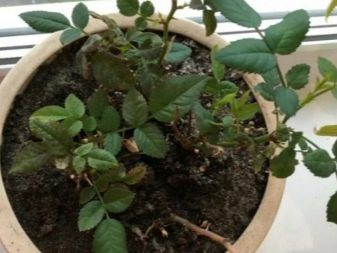


































































































The comment was sent successfully.